Overwintering caladiums is the best way to keep your favorite varieties year after year!
Saving caladium bulbs over winter can sometimes be a bit of a challenge, but it’s not terribly difficult. Don’t worry, I’ll show you exactly what to do in this post!
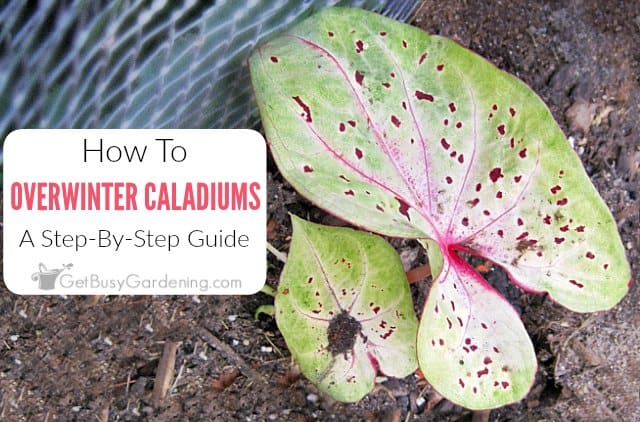
Even if you live in a cold climate like I do here in MN, it’s not hard to keep caladiums through the winter, and replant them again each spring.
That’s a good thing, because I am a sucker for their gorgeous foliage. Every year I seem to end up buying at least one, because they’re so beautiful and unique.
But it’s expensive to buy them new every year. So I like to dig them up, and store my caladiums through the winter. That way I can save myself a little cash in the spring.
Below I will show all you need to know about how to overwinter caladiums. I’ll explain everything from when and how to dig them up, the best ways to store them, and when to replant them in the spring.
Are Caladiums Perennials Or Annuals?
It’s common to find caladium plants for sale in the annuals section of garden centers.
But they’re actually tender perennials that can survive for many years with the proper winter care.
They can be left in the ground if you live in a warm climate (zone 9 or higher). But for most of us, they won’t survive the winter if left outside. So they must be brought indoors in the fall.
Related Post: How To Overwinter Plants: The Complete Guide
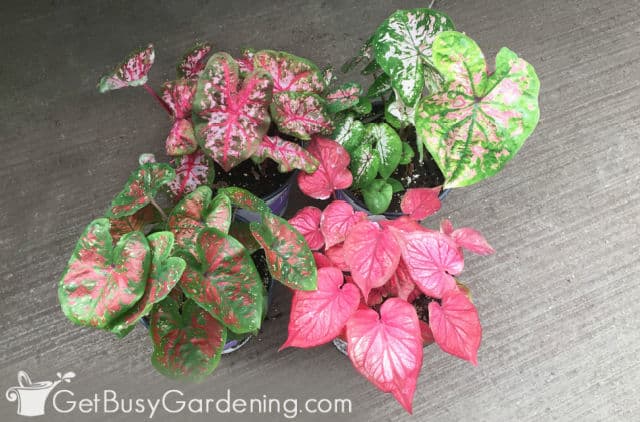
3 Methods Of Overwintering Caladiums
There are three ways to overwinter caladiums, and these methods will work for all varieties. The technique you choose will depend on your climate, and where you planted them.
- Leaving the bulbs in the garden over winter (if you live in a warm enough climate)
- Storing them in pots over winter
- Digging up and storing the tubers in the fall
How To Overwinter Caladium Bulbs
In this section, I will describe each of the three methods for overwintering caladiums in detail.
The method you choose will depend on where you live in, and whether you have them in pots or the garden.
1. Overwintering Caladium Bulbs In The Ground
If you’re lucky enough to live in a warm enough climate (zone 9+), you can just leave your caladiums right in the ground all winter.
They will eventually go dormant, and all the foliage will die back. But, once the soil warms in the spring, they’ll come back better than ever.
If you plan to leave them in the ground, then be sure they’re in a protected spot where they won’t get too much water. If kept too wet, the bulbs could end up rotting.
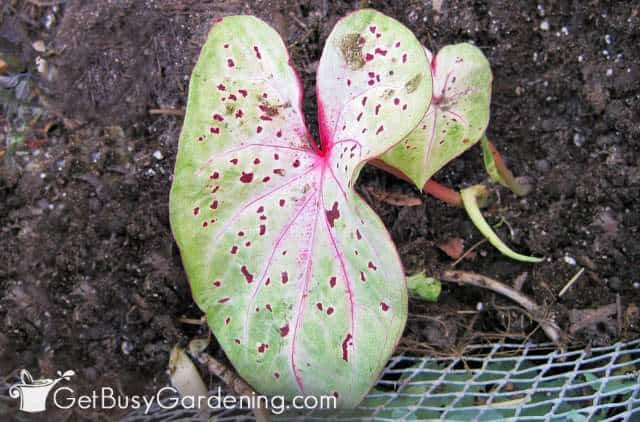
2. Overwintering Caladiums In Pots
If your caladiums are in containers, you can overwinter them right in their pots.
If you bring them indoors before the temperature outside gets below 60°F, you can extend their growing season by several weeks.
Otherwise, as it gets cooler in the fall, they will naturally start to go dormant, and the leaves will begin to die back.
They are not cold hardy at at all, so be sure to bring them indoors before the temps drop below 55°F, or the bulb may not survive.
Once the plant has died back, cut off all of the leaves. Then store the pot in a dry location where the temperature stays around 60°F. Allow the soil to dry out, and don’t water it all winter.
3. Digging & Storing Caladium Bulbs For The Winter
Digging and storing the tubers is the most popular way to overwinter caladiums. With this technique, you lift the whole plant out of the ground, bulbs and all.
They are very sensitive to cold, so it’s extremely important that you lift them before it drops too low. Ideally, you should do it when it’s above 60°F, but definitely not below 50°F.
If you leave them in the ground too long, frost could end up damaging the bulb, which means it likely won’t survive the winter in storage.
Related Post: How To Store Bulbs For The Winter
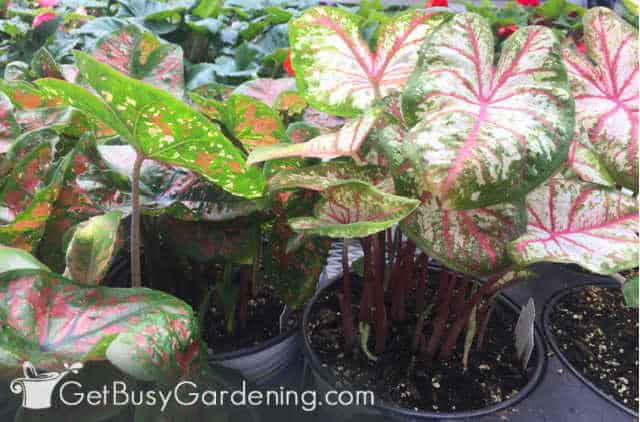
Preparing Caladiums For Winter Storage
The most common method of overwintering caladiums is digging the tubers out of the ground and storing them.
Below I’ll give you details about lifting them, and instructions for how to store the bulbs for winter.
When To Dig Up Caladiums
Since they will not tolerate frost, you should dig up your caladiums before it gets too cold outside.
The foliage will naturally start to die back once the temperature gets below 60°F.
But it may not die completely before they need to be lifted, which is fine. The leaves will eventually die back all the way once the bulb goes dormant after you lift them.
How To Dig Up Caladium Tubers
Use a garden fork or spade shovel to gently lift them out of the ground. Take care to start digging far enough away from the center of the plant so that you don’t accidentally cut or damage the tubers.
You can gently shake or brush off the excess dirt, but don’t rinse it off. You don’t want the tuber to be wet before storing it.
Then check to make sure none of them are damaged or showing signs of rot. Damaged or rotting bulbs will not store well and should be discarded.
Curing Caladium Tubers Before Overwintering
Once you’ve lifted the tubers from the ground, allow them to cure (dry out) for a week or so before storing them.
After they have cured, the leaves will drop off, or easily pull away from the tuber. Remove all of the dead leaves before storing the bulbs for winter.
How To Store Caladium Bulbs For Winter
To successfully overwinter caladiums, you must pack and store the bulbs correctly. Doing this wrong is by far the most common mistakes that newbies make.
Packing The Bulbs For Storage
It’s very important to use a good packing material for storing your caladium bulbs.
It should be totally dry, and lightweight enough so that the tubers can breath, otherwise they may end up molding or rotting.
The type of storage container you use is also important. For best results, choose something made out of cardboard or paper rather than plastic.
Plastic holds too much moisture, which you don’t want for dormant bulbs.
I like to pack mine into a cardboard box filled with either dry peat moss or coco coir. But you could mix in some perlite if you have that on hand.
Or try using another type of medium like sawdust, newspaper, or pet bedding. Pack the bulbs loosely with plenty of material around them so they aren’t touching each other.
Where To Store Caladium Bulbs
You can store caladium bulbs in the basement, a heated garage, or a closet. As long as they stay cool and dry, they should be good to go.
Place the box on a shelf in cool, dark location where they will stay dry. Keep the temperature around 60°F.
Caladium Winter Care Tips
The hardest part about overwintering caladiums is making sure the bulbs don’t get too much moisture.
This is true whether you left them in the ground, in pots, or packed them for storage. If they get too much water during the winter, they will rot.
It’s also a good idea to check on them a few times to make sure they aren’t molding or drying out too much.
If you find any that have mold on them, throw them out immediately so that it doesn’t spread to the other bulbs.
Replanting Caladium Bulbs After Overwintering
When it comes to replanting your caladium bulbs in the spring, it’s very important to get the timing right. Follow the instructions below for the best results.
When To Plant Caladiums
Wait to replant caladiums until there’s no more chance of frost of the spring.
It’s also important to wait until the ground has warmed to 65°F, and has had a chance to dry out a bit. You can use a soil thermometer to check it.
Be patient here. It is not beneficial to plant them early. If the ground is soggy and cold, the tubers will be extremely slow to sprout. Or worse, they may end up rotting.
For dormant potted caladiums, bring them out of storage 4-6 weeks before your last frost date.
Give them a deep drink of water, and put them in a bright, warm spot. Wait to move them back outside until it’s above 60°F.
How To Prepare Caladium Bulbs For Planting
To help break dormancy and wake them up faster, you can soak caladium bulbs before planting them.
Fill a bowl or bucket with warm water, and soak them for 2-12 hours. I like to soak mine in compost tea to give them even more of a boost.
Then, after planting my tubers, I pour the rest of the compost tea I used to soak them over the top to water them.
Starting Caladium Tubers Indoors
If you want to get your tubers replanted earlier, you can start them indoors 4-6 weeks before your average last frost. Plant them in a container filled with potting soil.
Water until it starts coming out of the holes in the bottom of the pot, and allow the excess to drain completely.
Then place them in a warm, bright location. Putting them on a heat mat will help them sprout faster.
Related Post: How To Grow & Care For Caladiums
FAQs About Overwintering Caladiums
Below you’ll find the answers to some of the most common questions I get about how to overwinter caladiums. If you can’t find yours here, leave a comment below.
Can caladiums grow indoors?
Technically yes, caladiums can grow indoors, but it is pretty difficult. They naturally require a dormant period during the winter months, so it’s best to allow them to rest.
You could certainly try keeping yours indoors through the summer, and then allow it to go dormant during the winter.
Can you overwinter caladiums in pots?
Yes, you can leave caladiums in pots over winter. Allow the soil to dry out completely, remove all of the leaves after they die back, and store the pot in a cool, dark, and dry location until spring.
Can you leave caladium bulbs in the ground over winter?
You can leave caladiums bulbs in the ground over winter if you live somewhere warm enough. They are hardy in USDA zones 9 and above.
Do caladiums come back every year?
Yes, caladiums do come back every year. With the proper winter care, they will survive and grow back year after year.
How long can you store caladium bulbs?
You can store caladium bulbs for several months in the right conditions. Don’t try to keep them dormant for too long though, I recommend replanting them every spring.
But if for some reason you are unable to plant them right away in the spring, keeping them in storage for a few extra weeks should be fine.
Just check on them periodically to be sure the bulbs aren’t too dried out.
Now that you know how to save caladiums over winter, you can keep your favorite varieties year after year.
Plus, once you get the hang of overwintering caladiums, you won’t have to feel guilty buying new plants every year.
If you want to learn all there is to know about maintaining healthy indoor plants, then you need my Houseplant Care eBook. It will show you everything you need to know about how to keep every plant in your home thriving. Download your copy now!
More Posts About Overwintering Plants
- How To Store Dahlia Tubers For Winter
- How To Overwinter Tuberous Begonias
- Overwintering & Storing Canna Lily Bulbs – The Complete Guide
- How To Store Amaryllis Bulbs For The Winter
- How To Bring A Plant Out Of Dormancy
- Dormant Cyclamen Care: When, What To Do, & How To Revive It
Share your tips for overwintering caladiums in the comments section below.
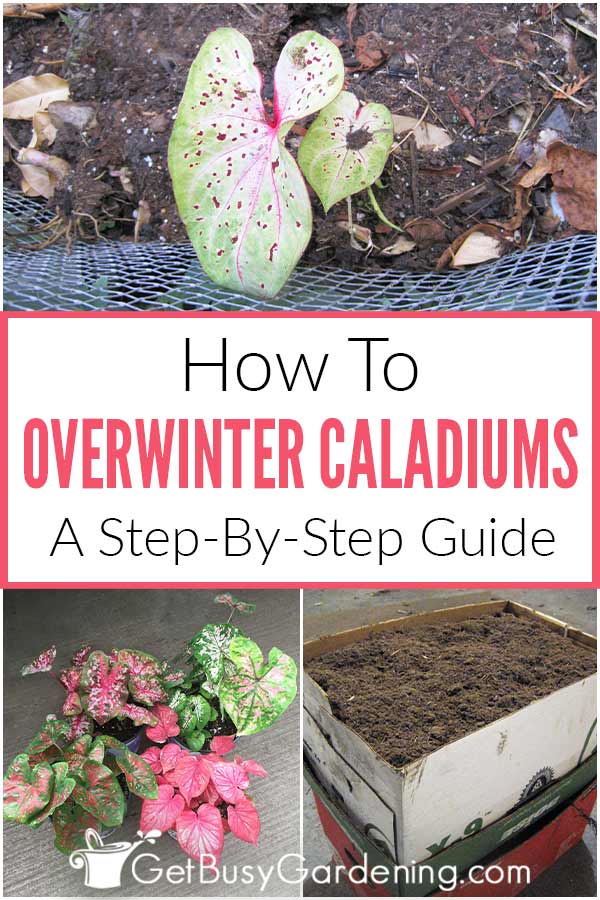
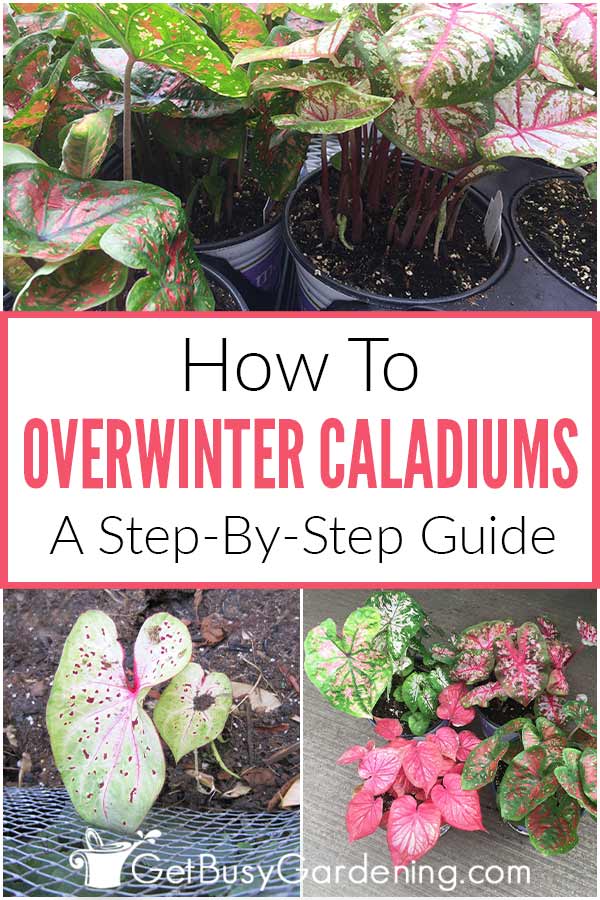


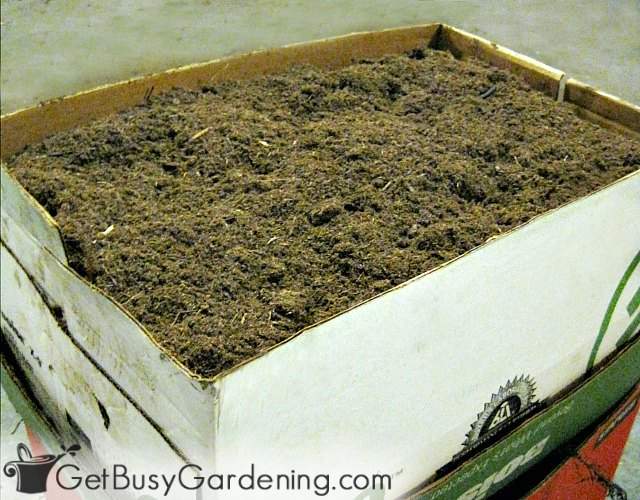


Gordon Dunne says
After I knock off loose soil from the tuber, do I cut the roots before boxing in peat or other medium?
Amy Andrychowicz says
There’s no need to cut off the roots before packing your caladium bulbs for winter storage.
Kate says
If I want to skip a season and not plant my caladiums, how do I care for them? I have dozens and I don’t want them blooming if they’re not in the ground.
Amy Andrychowicz says
It can be difficult to store caladium bulbs for more than just a few months during the winter. They tend to either start sprouting in storage, or dry out over time. If you have no choice but to keep them in storage for more than a year, then try your best to prevent them from drying out. Check on them every few months, and lightly mist the ones that are dry. Don’t overdo it though. If they get too wet, they could end up rotting. It’s a bit of a juggling act.
marti walker says
When overwintering the bulbs – how do you keep them from drying out during long winters, without causing them to mold or rot ?
Amy Andrychowicz says
I pack my caladiums in box full of peat moss or coco coir, both of which help to retain moisture to keep the bulbs from drying out. Just make sure it’s dry so the bulbs won’t rot. If you find they are drying out too fast, you can spray them with a very fine mist of water. But don’t saturate them.
Bailey says
I live in the UK and recently bought an indoor caladium. It’s winter over here and I’ve had my plant in my warm bedroom with lots of moisture, heat and good lighting. Will my plant continue to grow and flower throughout the year now? Or Will I have messed up the growing cycle by not allowing it to die back down? It currently has some new growth on it too but I have lost two leaves.
Amy Andrychowicz says
Awesome to hear that you’ve been able to keep your caladium growing over the winter so far, how fun! However, they do indeed require a period of dormancy in order to continue to look their best. If you don’t follow their normal pattern of going dormant during the winter, then it most likely will screw up their natural clock. So it is best to allow them to naturally go dormant in the fall, and overwinter them as I describe in the article. Yours will eventually start to go dormant on its own, which it might already be doing if it’s starting to drop leaves. Make sure you give it a 4-5 month dormancy period before trying to wake it up in the spring/summer. Good luck!
Marty and Joy Posthauer says
If I’m wintering over caladiums in pots in my basement that stays at about 60 degrees should I water at all or just let it dry out completely?
Amy Andrychowicz says
Keep the soil dry, but don’t let the bulbs dry out completely. It’s best to check on your dormant caladiums monthly through the winter to see how dry they are getting. Stick your finger down into the soil to where the bulbs are. If it feels completely bone dry, then give them a little water. Otherwise, leave them be. 🙂
Molly Turner says
I live in zone 7 and our recent winters have been mild but too cold to leave caladiums outside. I’m concerned the bulbs will dry out and how to add moisture and how to know if they’re too wet or too dry? Will they be ok if stored in sawdust or newspaper? Don’t have dry peat but will purchase any suggestion you have that’s available locally. I do have lots of straw! I’ll have to store them in a storage building on our property because the attached garage is insulated and will be too warm. Thank you!
Amy Andrychowicz says
Yes, sawdust would work great for packing caladium bulbs for winter storage. I would definitely use that over newspaper, because it holds more moisture. Check on the bulbs a few times during the winter to make sure they aren’t too wet or drying out.
Rita Hilbmann says
My caladium leaves are beginning to droop (larger/taller ones) while new leaves continue to dazzle. Is this a cycle in their growth? I’m in Quantico VA and beginning to notice change in weather at nights, so I’m assuming I’ll be un-potting my bulbs for storage. Thank you, all, for your tips. Can’t wait to see if my bulbs have gotten bigger.
Amy Andrychowicz says
Yes, as the nights get cooler, caladiums will start to go dormant, which is what sounds like is happening to your plant. You can bring the pot inside, and leave the dormant bulbs in it overwinter if you want. But if un-potting them is easier, then that works too. 🙂
Susan Czer says
I live in zone 4-5 – need to lift them from the ground and put them in storage. After they are all prepared and put in a box with moss or whatever and placed in a cool dark place (my basement storage area) …Do I water them at all or not at all? Instructions says everything should be dry But don’t let the bulbs dry out over winter HUH??
Thanks
Amy Andrychowicz says
Yes, everything should be dry so that the caladium bulbs don’t rot over the winter. If your packing material is wet, or you store them in a damp location, then it will likely cause your bulbs to rot. The bulbs themselves have moisture in them, which you want them to hold onto. You don’t want the bulbs to allow them to dry out completely. The packing material is there to insulate the bulbs, so they don’t completely dry out. If you just left them on a shelf by themselves, with no protection, then they likely would not survive. It can be a delicate balance sometimes. 🙂 Hopefully that makes more sense.
Karen says
Hello, what kind of caladium is the one pictured?
Amy Andrychowicz says
Sorry, but I never got an ID with it.
Katie says
It looks like a Miss Muffett to me!
Robert J Hartwig says
I tried starting caladiums in my house in March to get a jump on the growing season. Nothing happened until I put a couple of pots directly on a hot air heating vent. They then sprouted quickly. These things like it hot.
Amy Andrychowicz says
Thanks for sharing this great tip for how to bring caladiums out of dormancy!
jay.j.jacobsen says
Here’s the deal with these plants: When the temperature is constantly below 60 degrees, but not yet frost, remove the whole plant from the soil, line them up in a basement, tubers not touching. Let them wilt.
Then, cover with peat and vermiculite. In the spring, plant in rich soil again when weather gets warm. These plants need heat to sprout again. I usually plant in pots, and then have the pots sit on the patio where it is warmer than the flower bed soil. Then, after they’ve had a good start, submerge the pots into the flower bed soil, mulch. You’d never know that there was a pot there! Plus the pot keeps the plants from competing with other roots.
Amy Andrychowicz says
Awesome, thanks for adding your tips for overwintering caladium bulbs!
Gardener on Sherlock Street says
I usually let the pot my caladiums are growing in go dry and then bring it inside and tuck it somewhere out of the way. I put it back outside once all frost chances have past and water it well. Keep it moist at this point, but don’t expect any sprouts until it gets good and warm. Then feed it good and wait for the show. They do tend to decline after a few years and then I buy new ones.
Amy Andrychowicz says
Great, thanks for your tips and sharing the steps you take for overwintering your caladiums in pots! 🙂
mariyn says
I am in Zone 8. As far north in Florida as you can go. I was told by a professional to dig up my caladium bubs, make sure they are dry put them in a pot in a cool, not cold, place to overwinter them. Being a person who is prone to go against the best advice. I left them in the ground with my usual amount of winter much. They all survived our winter,below freezing many nights. They even multiplied. I have done this with elephant ears for several years also.
Amy Andrychowicz says
Wow, that is wonderful!! You’re lucky that you live somewhere warm enough that you can overwinter these plants right in the garden. 🙂
Tanya Brooks says
I do the same thing. I live in North Florida along the coast. We have been changed to Planting zone 9.
Amy Andrychowicz says
So jealous that you can leave your caladiums in the ground all winter! That would be so much easier, LOL!
Anonymous says
Last fall, I dug up my caladium tubers, dusted them off, allowed the to dry for a week or so, the put them in an old onion bag. I hung them in a cool, dry, dark place all winter. In May, when night temps were above 50, I planted them about 2″ deep in my pots. Watered and waited. It took a few weeks…maybe a little over a month before I saw any activity. Then all the sudden they started growing and ended up looking great. I plan on trying overwintering them again this fall.
Amy Andrychowicz says
Wow, good for you!! Thanks for sharing your tips for overwintering your caladiums. Good luck, I hope they will survive for you this year too.
Amy Andrychowicz says
@Anonymous – Wow, that is awesome!! Good for you! Thanks for sharing the details of how your overwintered your caladium tuber! How exciting that you have four bulbs now too. Good luck storing it again this winter, hope it works for you again!!
Anonymous says
I successfully overwintered my first caladium. I dug up the tuber before the first freeze, cut off all the foliage and stems, shook off as much soil as possible, then put the caladium tuber in a metal holiday cookie box with a tightly-fitting lid and a bunch of what seems to be wood shavings (had come with some bulbs I bought and I saved it). I made sure to put wood shavings all over the roots to dry up any excess moisture. Then i kept the covered metal box in a room with temp set at 55 degrees all winter (to save on my electric bill, not to baby the caladium!). Come warm weather in spring, I replanted it. It took quite a while, but eventually leaves appeared, and the thing was much bigger than the previous year. This fall when i dug up the tuber I discovered it was now four tubers– apparently it pupped over the summer! I'm just hoping I didn't leave it too late this time around.